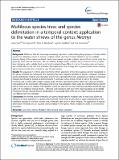Por favor, use este identificador para citar o enlazar a este item:
http://hdl.handle.net/10261/125554COMPARTIR / EXPORTAR:
 SHARE SHARE
 CORE
BASE CORE
BASE
|
|
| Visualizar otros formatos: MARC | Dublin Core | RDF | ORE | MODS | METS | DIDL | DATACITE | |

| Título: | Multilocus species trees and species delimitation in a temporal context: application to the water shrews of the genus Neomys |
Autor: | Igea, Javier CSIC ORCID; Aymerich, Pere; Bannikova, Anna A.; Gosálbez, Joaquim; Castresana, José CSIC ORCID | Palabras clave: | Gene flow Introns Mutation rates Relaxed clock Speciation |
Fecha de publicación: | 29-sep-2015 | Editor: | BioMed Central | Citación: | BMC Evolutionary Biology 15: 209 (2015) | Resumen: | [Background]
Multilocus data are becoming increasingly important in determining the phylogeny of closely related species and delimiting species. In species complexes where unequivocal fossil calibrations are not available, rigorous dating of the coalescence-based species trees requires accurate mutation rates of the loci under study but, generally, these rates are unknown. Here, we obtained lineage-specific mutation rates of these loci from a higher-level phylogeny with a reliable fossil record and investigated how different choices of mutation rates and species tree models affected the split time estimates. We implemented this strategy with a genus of water shrews, Neomys, whose taxonomy has been contentious over the last century. [Results] We sequenced 13 introns and cytochrome b from specimens of the three species currently recognized in this genus including two subspecies of N. anomalus that were originally described as species. A Bayesian multilocus species delimitation method and estimation of gene flow supported that these subspecies are distinct evolutionary lineages that should be treated as distinct species: N. anomalus (sensu stricto), limited to part of the Iberian Peninsula, and N. milleri, with a larger Eurasian range. We then estimated mutation rates from a Bayesian relaxed clock analysis of the mammalian orthologues with several fossil calibrations. Next, using the estimated Neomys-specific rates for each locus in an isolation-with-migration model, the split time for these sister taxa was dated at 0.40 Myr ago (with a 95 % confidence interval of 0.26 – 0.86 Myr), likely coinciding with one of the major glaciations of the Middle Pleistocene. We also showed that the extrapolation of non-specific rates or the use of simpler models would lead to very different split time estimates. [Conclusions] We showed that the estimation of rigorous lineage-specific mutation rates for each locus allows the inference of robust split times in a species tree framework. These times, in turn, afford a better understanding of the timeframe required to achieve isolation and, eventually, speciation in sister lineages. The application of species delimitation methods and an accurate dating strategy to the genus Neomys helped to clarify its controversial taxonomy. |
Versión del editor: | http://dx.doi.org/10.1186/s12862-015-0485-z | URI: | http://hdl.handle.net/10261/125554 | DOI: | 10.1186/s12862-015-0485-z | ISSN: | 1471-2148 |
| Aparece en las colecciones: | (IBE) Artículos |
Ficheros en este ítem:
| Fichero | Descripción | Tamaño | Formato | |
|---|---|---|---|---|
| 12862_2015_Article_485.pdf | 1,2 MB | Adobe PDF |  Visualizar/Abrir |
CORE Recommender
PubMed Central
Citations
7
checked on 31-mar-2024
SCOPUSTM
Citations
25
checked on 11-abr-2024
WEB OF SCIENCETM
Citations
24
checked on 25-feb-2024
Page view(s)
307
checked on 18-abr-2024
Download(s)
198
checked on 18-abr-2024

